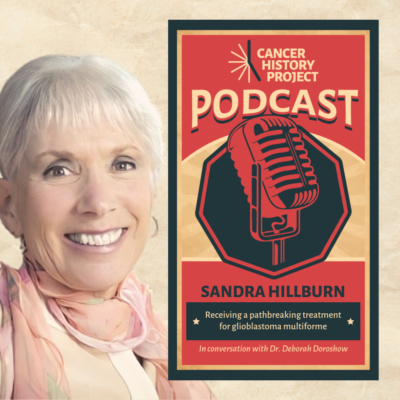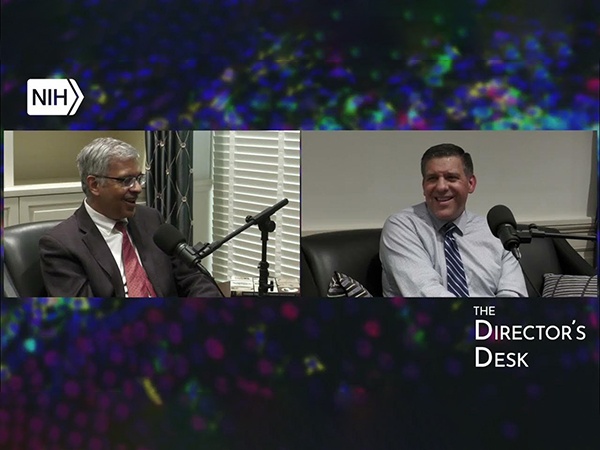

Sandra Hillburn on the CMV treatment that saved her life from GBM
By Alexandria Carolan | April 28, 2023
Sandra Hillburn walked miles every day with a friend. She hiked mountains, played golf and tennis, and skied. In 2005, those things began to feel impossible.
“I just started to feel weaker and weaker and went from doctor to doctor, looking for a diagnosis, which I did not receive,” Hillburn said in an interview with Deborah Doroshow, an oncologist at the Tisch Cancer Institute, Icahn School of Medicine at Mount Sinai.
Doroshow, who is also a historian of medicine, is a member of the editorial board of the Cancer History Project.
Their conversation is available on the Cancer History Project podcast.
Slowly, Hilburn’s left side became paralyzed. At work, she couldn’t walk without leaning against a wall.
“Colleagues were passing me and saying, ‘I’m praying for you,’” said Hillburn, a Fort Lee, NJ, resident. “And still, I could not see what I looked like and that my left side was so weak. Even when I looked in the mirror, I didn’t see that the left side of my face fell, but I knew something was wrong and it wasn’t being diagnosed.”
Seventeen years ago, in April 2006, Hillburn’s daughter brought her to a doctor in New York City. The doctor thought Hillburn was having a stroke, and sent her for a CAT scan.
“That showed that I had a brain mass and I was admitted on an emergency basis to a New York City hospital where I was told I had two or three months to live with surgery, chemotherapy, radiation, and then, palliative care,” Hillburn said.
Hillburn was diagnosed with stage 4 glioblastoma multiforme.
The family heard through a friend that doctors at Duke Cancer Institute were developing new treatments for glioblastoma, the cancer she was diagnosed with. From there, Hillburn met with Allan Friedman, a neurosurgeon at Duke Cancer Center’s Brain Tumor Clinic.
Her first treatment would be brain surgery.
“There was no choice. I was fading fast. By the time I got to Duke, I could hardly walk or talk. And I was so weak, breathing was becoming difficult,” she said. “I couldn’t wait for the surgery. And when I met Allan Friedman before the surgery, I had such confidence in him. He was just so kind and brilliant.”
The plan was for Friedman to implant a shunt into Hillburn’s brain in addition to removing what he could of the glioblastoma, from there, Hillburn would be treated with monoclonal antibodies. However, the structure of Hillburn’s brain didn’t allow for the shunt to be placed.
Regardless, the surgery was a success. Hillburn felt better afterward, but her doctors had to find a new treatment plan.
A clinical trial led by John Sampson, a neurosurgeon and spine surgeon at Duke Cancer Center Brain Tumor Clinic, became her next treatment option. Before she knew what the study entailed, she said yes.
“If they thought it was good for me, I did too. Yes. I didn’t think I had that much to lose,” she said.
The treatment: An experimental cancer vaccine therapy.
Hillburn’s white blood cells were extracted and exposed to cytomegalovirus (CMV), which is found in glioblastoma cells. From there, doctors created a vaccine designed to target Hillburn’s glioblastoma. She also received chemotherapy and radiation.
“Honestly, I can’t complain about any side effects from any of it. I know people do, but I was still playing golf and I thought I played better golf with the Temodar because it slowed me down,” she said. “I really didn’t have negative experiences.”
Hillburn’s sister and brother-in-law welcomed Hillburn into their home, where she lived for five months while she received radiation treatment at Mount Sinai.
“Not only were they great company, but my sister accompanied me wherever we went,” Hillburn said. “We laughed at the most stupid things. We giggled like when we were children and she accompanied me to Duke for the first year, at least. She’s been my partner throughout.”
Hillburn traveled to Duke once a month for the vaccine.
“At first, I thought it was daunting,” she said. ‘How am I going to do this?’ And then I thought, ‘Well, it’s my new job.’ I had always worked, so I just looked at it like that.”
The cancer treatment team at Duke, especially the nurses, made Hillburn’s visit enjoyable.
“The nurses, Denise Lally-Goss and Beth Perry who are on the research team, I just about jump into their arms when I see them,” she said. “Everybody is so loving and caring. I looked forward to going down there. I didn’t mind it at all. The worst part was just getting to the airport.”
Soon, it became clear the treatment was working.
“I felt it,” Hillburn said. “I just felt good. I started walking my steep hills and I just was very fortunate, the surgery just was so positive, and I felt and functioned as I did before the tumor, and the vaccine keeps me going.”
After a while, Hillburn began to wonder whether the vaccine was still helping, or whether her body was able to fight off the glioblastoma without the help. Then COVID-19 hit, and hospitals enforced restrictions and limited the number of visits.
“After the coronavirus hit, I had to wait a year before getting to Duke, and the lymph nodes near my groin started to really ache,” she said. “I had that feeling when I had cancer.”
A few weeks after Hillburn developed this feeling, she received the vaccine again.
“I know it’s the vaccine, because I got the vaccine and my lymph nodes stopped hurting. So I thought, ‘Aha, not me. It is the vaccine for sure,’” she said. “And I know that it’s given me a good quality of life.”
Every six months, Hillburn looks forward to visiting Duke to receive the cancer vaccine.
Every weekend, Henry Friedman, James B. Powell, Jr. Distinguished Professor of Pediatric Oncology in the School of Medicine, professor of neurosurgery, pediatrics, medicine, pathology, and member of the Duke Cancer Institute, who leads the Preston Robert Tisch Brain Tumor Center at Duke, gives her a call.
“He calls me every single weekend, for more than 16 years, to see how I’m doing. I even said to him at one point, ‘Henry, how about I’ll call you if I’m not doing well?’” she said. “He goes, ‘Will it be okay if I still call you?’ Oh, my goodness. Yes. I look forward to speaking to him.”
This column features the latest posts to the Cancer History Project by our growing list of contributors.
The Cancer History Project is a free, web-based, collaborative resource intended to mark the 50th anniversary of the National Cancer Act and designed to continue in perpetuity. The objective is to assemble a robust collection of historical documents and make them freely available.
Access to the Cancer History Project is open to the public at CancerHistoryProject.com. You can also follow us on Twitter at @CancerHistProj, or follow our podcast.
Is your institution a contributor to the Cancer History Project? Eligible institutions include cancer centers, advocacy groups, professional societies, pharmaceutical companies, and key organizations in oncology.
To apply to become a contributor, please contact admin@cancerhistoryproject.com.










